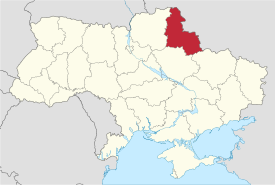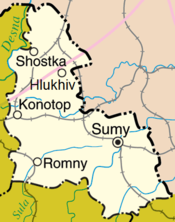Sumy Oblast
This article may be a rough translation from another language. It may have been generated, in whole or in part, by a computer or by a translator without dual proficiency. (April 2023) |
Sumy Oblast
Сумська область | |
|---|---|
| Sumska oblast[1] | |
|
| |
| Nickname: Сумщина (Sumshchyna) | |
 | |
| Country | |
| Administrative center | Sumy |
| Government | |
| • Governor | Volodymyr Artyukh |
| • Oblast council | 64[2] seats |
| • Chairperson | Viktor Fedorchenko |
| Area | |
• Total | 23,834 km2 (9,202 sq mi) |
| • Rank | Ranked 16th |
| Population (2022)[3] | |
• Total | |
| • Rank | Ranked 19th |
| GDP | |
| • Total | ₴ 105 billion (€2.7 billion) |
| • Per capita | ₴ 100,760 (€2,600) |
| Time zone | UTC+2 (EET) |
| • Summer (DST) | UTC+3 (EEST) |
| Postal code | |
| Area code | +380-54 |
| ISO 3166 code | UA-59 |
| Raions | 18 |
| Cities (total) | 15 |
| • Regional cities | 7 |
| Urban-type settlements | 20 |
| Villages | 1492 |
| HDI (2022) | 0.737[5] high |
| FIPS 10-4 | UP21 |
| NUTS statistical regions of Ukraine | UA12 |
| Website | sorada.gov.ua |
Sumy Oblast (Ukrainian: Сумська область, romanized: Sums'ka oblast'), also known as Sumshchyna (Сумщина), is an oblast (province) in northeast Ukraine. The oblast was created in its modern-day form, from the merging of raions from Kharkiv Oblast, Chernihiv Oblast, and Poltava Oblast in 1939 by the Presidium of the Supreme Soviet of the Soviet Union.
The estimated population is 1,035,772 (2022 estimate).[3]
The administrative center of the oblast is the city of Sumy. Other important cities within the oblast include Konotop, Okhtyrka, Romny, and Shostka. The modern region combines territories of the historical Severia (northern part) and Sloboda Ukraine (southern part). On territory of the Sumy Oblast important centers of Ukrainian culture are located, such as the city of Hlukhiv which served as a hetman residence during the Cossack Hetmanate as well as the cities of Okhtyrka and Sumy which were regional centers of the Sloboda Ukraine.
The oblast has a heavy mix of agriculture and industry, with over 600 industrial locations. Among the most notable was the Soviet film stock manufacturer Svema in Shostka. Importantly, seven rivers pass through the oblast.
Geography
[edit]Sumy Oblast | |
|---|---|
 | |
 |
The Sumy Oblast is situated in the northeastern part of Ukraine. In Ukraine it borders Chernihiv Oblast to its west, Poltava Oblast – southwest, and Kharkiv Oblast – southeast. To its east Sumy Oblast borders the Russian Federation including Bryansk on the northeast, Kursk and Belgorod on the east. The length of the state border with the Russian Federation is 563.8 km (350.3 mi). There are three railway border crossing (Volfine, Pushkarne, Zernove) and five highway border crossings (Bachivsk, Katerynivka, Ryzhivka, Yunakivka, Velyka Pysarivka). In regard to border crossings, since 2006 the city of Sumy has an airport which has an international checkpoint.
On its territory the Dnieper Lowland transitions east to the Central Russian Upland. The northern part of Sumy Oblast is part of the Polesie Lowland as its eastern region. Elevation is 110–240 m above sea level.[6] Its area (23,800 km2) constitutes 3.95% of the country.
Seven main rivers flow through the oblast, with Desna River being the largest.[6] All of them are transit because crossing the oblast flowing from the territory of the Russian Federation west towards Dnieper. All rivers in Sumy Oblast are part of the Dnieper River basin.
The Sumy Oblast contains 168 objects and territories of natural reserve. The oblast is rich in picturesque banks of numerous rivers, and sources of mineral waters. Major environmental problems are: soil erosion, pesticide pollution, air and water pollution. The city has a problem of garbage utilization. The only place for pesticide utilization in Ukraine[citation needed] is Shostka, Sumy Oblast.
History
[edit]The region was created on the ukase of Presidium of the Supreme Soviet of the Soviet Union on 10 January 1939 as part of the Ukrainian Soviet Socialist Republic. The newly created Sumy Oblast included 12 former raions of Kharkiv Oblast, 17 former raions of Chernihiv Oblast, and 2 former raions of Poltava Oblast.
During World War II in 1941–43, it was occupied by Nazi Germany under administration of the German Wehrmacht. After the German forces were driven out, the Soviet Union regained control of the region under jurisdiction of the Ukrainian Soviet Socialist Republic.
In 1965 one of former Chernihiv Oblast raions (Talalaivka Raion) was returned to Chernihiv Oblast.
During the 2022 Russian invasion of Ukraine the Sumy Oblast was one of the first regions where Russian and Ukrainian forces clashed.[7][8][9] Parts of the oblast came under Russian occupation during the invasion. On 4 April 2022 Governor of Sumy Oblast Dmytro Zhyvytskyi stated that Russian troops no longer occupied any towns or villages in Sumy Oblast and had mostly withdrawn, while Ukrainian troops were working to push out the remaining units.[10] On 8 April 2022 Zhyvytskyi stated that all Russian troops had left Sumy Oblast.[11]
On 9 June 2024, amid Russian cross-border operations in neighboring Kharkiv Oblast, Russian forces claimed to have attacked and captured the border village of Ryzhivka, though this was denied by Ukrainian authorities.[12][13]
Points of interest
[edit]The following historic-cultural sited were nominated for the Seven Wonders of Ukraine.
- Monument to a Mammoth (Kulishivka)
- Kruhlyi dvir (Round court)
- Sofroniiv Monastery
Administrative divisions
[edit]

It comprises 5 raions (districts) that are further subdivided into 51 territorial hromadas (communities).
The following data incorporates the number of each type of administrative divisions of the Sumy Oblast:
The local administration of the oblast is controlled by the Sumy Oblast council. The governor of the oblast (chairman of state regional administration) is appointed by the President of Ukraine.
Demographics
[edit]

At the 2001 census, the ethnic groups within the Sumy Oblast were: 88.8% Ukrainians, 9.4% Russians.[14] A major Russian subethnicity in the region is the Goryuns.
Age structure
[edit]- 0-14 years: 12.7%
 (male 74,529/female 70,521)
(male 74,529/female 70,521) - 15-64 years: 70.8%
 (male 386,250/female 422,077)
(male 386,250/female 422,077) - 65 years and over: 16.5%
 (male 60,374/female 127,306) (2013 official)[citation needed]
(male 60,374/female 127,306) (2013 official)[citation needed]
Median age
[edit]- total: 42.0 years

- male: 38.6 years

- female: 45.4 years
 (2013 official)[citation needed]
(2013 official)[citation needed]
Economy
[edit]Industry
[edit]The main industrial activities of the oblast are: chemical mechanical engineering, pumping and energy mechanical engineering, agricultural machine-construction, instrument-making industry and radio electronics, technical equipment production for processing fields of agro-industrial complexes, mining and iron ore production industry, polygraph industry and medicine production, oil and gas processing, chemical production, film and photo material production (See: Svema), and chemical fertilizer production. In general, there are 273 large industry enterprises and 327 small industry enterprises.
Agriculture
[edit]In 1999, the gross grain yield was about 446,000 tons, sugar beets – 664,000 tons, sunflower seeds – 27,700 tons, potatoes – 343,600 tons. The region also produced 108,700 tons of meat, 517,800 tons of milk and 295,300,000 eggs. At the beginning of 1999, there were 781 registered farms in the oblast.
Notable people from Sumy Oblast
[edit]- Viktor Yushchenko – 3rd President of Ukraine (2005–2010); Khoruzhivka village
- Yevhen Adamtsevych – a Ukrainian bandurist, the author of Zaporizhian March
- Ivan Bahrianyi – a Ukrainian poet and a political leader in exile; Okhtyrka
- Oleksi Berest – one of the soldiers who hoisted the Victory Banner in Berlin and a posthumous Hero of Ukraine.
- Dmitry Bortniansky – a Ukrainian composer; Hlukhiv
- Dmitry Chechulin – chief architect of Moscow; born in Shostka in 1901
- Thomas de Hartmann, composer
- Volodymyr Holubnychy – race walker, Olympic gold medal; Sumy
- Abram Ioffe, an academician, "father of the Soviet physics"; Romny
- Ivan Nikitovich Kozhedub – WWII ace and air marshal of the Soviet Union.
- Panteleimon Kulish, Ukrainian writer, author of Ukrainian alphabet variation; Voronizh
- Vladimir Kuts, long distance runner, Olympic gold medal; Trostianets Raion
- Mykola Khvylovy, poet, one of the most recognized members of the so called Executed Renaissance
- Ada Rohovtseva, stage actress of theater and cinema, People's Actor of Ukraine, USSR People's Actor, Hero of Ukraine
- Andrey Razumovsky, son of Kyrylo Rozumovsky, Active Privy Councillor, 1st class
- Natalia Ivanovna Sedova – Wife of Leon Trotsky, born in Romny in 1882
- Stephen Timoshenko – considered as "America's father of engineering mechanics" (1878-1972)
- Leonid Toptunov – senior reactor control chief engineer at the Chernobyl Nuclear Power Plant Reactor Unit 4 on the night of the Chernobyl disaster
- Vladimir Sakhenko, painter and ceramist
Nomenclature
[edit]Most of Ukraine's oblasts are named after their capital cities, officially referred to as "oblast centers" (Ukrainian: обласний центр, translit. oblasnyi tsentr). The name of each oblast is a relative adjective, formed by adding a feminine suffix to the name of respective center city: Sumy is the center of the Sums’ka oblast (Sumy Oblast). Most oblasts are also sometimes referred to in a feminine noun form, following the convention of traditional regional place names, ending with the suffix "-shchyna", as is the case with the Sumy Oblast, Sumshchyna.
Gallery
[edit]-
Skyline of Sumy
-
St. George's Church in Okhtyrka
-
Putyvl Fortress
-
Kruhlyi dvir in Trostianets
-
Trostianets Park
-
Nikanor Onatsky Art Museum
-
Transfiguration Cathedral
-
Sumy, square Pokrovska
-
Monument to Taras
See also
[edit]References
[edit]- ^ Syvak, Nina; Ponomarenko, Valerii; Khodzinska, Olha; Lakeichuk, Iryna (2011). Veklych, Lesia (ed.). Toponymic Guidelines for Map and Other Editors for International Use (PDF). scientific consultant Iryna Rudenko; reviewed by Nataliia Kizilowa; translated by Olha Khodzinska. Kyiv: DerzhHeoKadastr and Kartographia. p. 20. ISBN 978-966-475-839-7. Retrieved 6 October 2020.
{{cite book}}:|website=ignored (help) - ^ (in Ukrainian) List of members of the Sumy Regional Council of the Sixth Convocation Archived 1 October 2020 at the Wayback Machine, Official website Sumy Parliament
- ^ a b Чисельність наявного населення України на 1 січня 2022 [Number of Present Population of Ukraine, as of January 1, 2022] (PDF) (in Ukrainian and English). Kyiv: State Statistics Service of Ukraine. Archived (PDF) from the original on 4 July 2022.
- ^ "Валовии регіональнии продукт".
- ^ "Sub-national HDI - Area Database - Global Data Lab". hdi.globaldatalab.org.
- ^ a b "ІNVESTMENT PASSPORT of Sumy oblast" (PDF). investukraine.com. State Agency for Investment and National Projects of Ukraine. 2013. Archived from the original (PDF) on 13 August 2014. Retrieved 12 August 2014.
- ^ "Украинские пограничники сообщили об атаке границы со стороны России и Белоруссии". Interfax. 24 February 2022. Archived from the original on 24 February 2022. Retrieved 24 February 2022.
- ^ "Войска России на севере Украины продвинулись вглубь до пяти километров – Арестович". Archived from the original on 24 February 2022. Retrieved 24 February 2022.
- ^ "Перші три дні повномасштабної російсько-української війни (текстовий онлайн) | Громадське телебачення". Hromadske (in Ukrainian). 24 February 2022. Archived from the original on 24 February 2022. Retrieved 24 February 2022.
- ^ Russian troops no longer hold any settlements in Ukraine's Sumy region, says governor, National Post (4 April 2022)
- ^ Sumy region liberated from Russian troops, Ukrayinska Pravda (8 April 2022)
- ^ "Кадыров заявил, что войска РФ захватили село в Сумской области".
- ^ "Ukrainian official denies Russian troops take border village in northeast". Reuters. 10 June 2024.
- ^ "Results of the population census of Ukraine in 2001". Demoscope Weekly.
External links
[edit]- State Administration of Sumy Oblast – official site (in Ukrainian)
- Information Card of the Region – official site of the Cabinet of Ministers of Ukraine
- Independent regional Web-portal – news, features, entertainment & tourism info (in Ukrainian)













